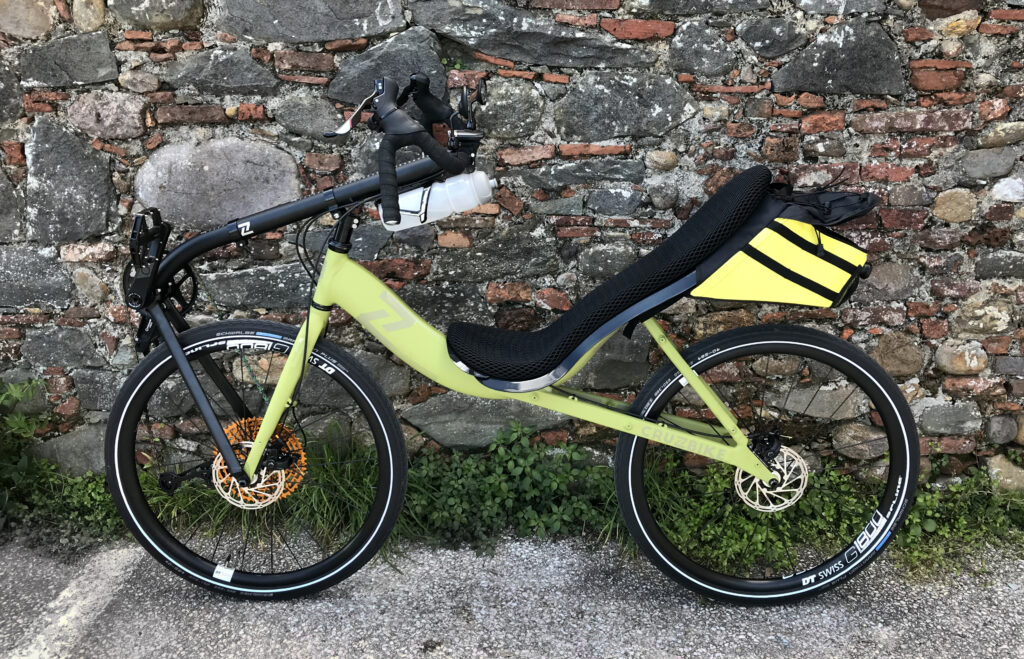part 2
Being an avid convert to recumbent bikes, it’s sometimes hard to admit, they’re not perfect. But I still gloat, because I have a secret. For almost every disadvantage to recumbent bikes, there’s an equal and opposite advantage. Ordinary diamond frame bike riders haven’t a clue. They’re caught in the ordinary, crowd-following, ingrained world of the wedgie. Likely, they’ve been simply misinformed. They have zero experience riding a recumbent, so consequently their imagination carries them off into the belief that bents are weird, awkward, bizarre, dysfunctional, and possibly dangerous. They think bents are mostly for wackos who want to show-off and attract attention. And I’ll admit, I like the attention. I like standing out from the crowd, especially on the road. Mostly, though, I like knowing that the real reasons for riding a bent can be quantified, explained and enumerated. Words, though, don’t mean a thing until you experience the ride for yourself.
In the spirit of fairness, here is the list of cons for recumbents. I surprised myself by finding ten of them—wasn’t expecting that many. And I’ll surprise you with a counter (or more) for all but two of them.
Cons—
- Seat lower, head lower, feels more vulnerable/less visible to traffic.
- Harder to start uphill.
- Can’t rise off saddle to engage upper body and gravity for hill climbs.
- Can’t rise off saddle for bumps and rough roads.
- More body contact with bike, ride feels harsher.
- More difficult to turn head to look behind.
- Always in same position on long rides.
- Heavier than most road bikes.
- Nonstandard frame makes for difficult rack mounting/transporting.
- Cost more, especially at the lower end, makes for entry level barrier.
Pros—
- Head position looks forward (not hunched over the road), better view of the scenery and traffic.
- lower center of gravity, more stable.
- less distance to fall, no flying head first over the handlebars.
- unusual appearance gets more attention from drivers.
- head is about the same height as a car driver (on most two-wheel recumbents).
- Starting uphill is part of the learning curve; once learned, it’s not an issue.
- Instead you make full use of your leg strength by pushing back on the seat, not limited by your own weight.
- Don’t have to get off saddle at a stop.
- No counter for this one, you’ll feel the road more (wider tires help*).
- Mirrors, mirrors, mirrors—all riders should use mirrors.
- Always in same comfortable position.
- no back pain.
- no neck pain.
- no arm/wrist pain.
- no perineum pain.
- no need for special padded pants.
- while other riders start complaining, recumbent riders are still having fun and ready for more.
- Heavier, yes, but. . .
- torso is “open” allowing for deeper breathing.
- more aerodynamic, less drag, faster on flats and downhill.
- and again #3 helps compensate.
- Yes, challenging, use racks that bike tires rest on, rather than hanging by the frame.
- More than pays for itself with benefits.
- enjoy riding more.
- enjoy riding farther.
- enjoy the view—the scenery, the trees, the sky, the horizon. . .
- enjoy how good you feel after every ride.
- And a bonus advantage that applies to MBB (Moving Bottom Bracket), or front wheel drive recumbents : More upper body use—arms and abdominals. The harder you peddle, the more counterforce your arms need to apply to the keep the front wheel going in the intended direction, particularly when climbing. This works in a way similar to standing on a diamond frame. And a double bonus for MBBs, you can feel the power going to the front wheel. You’ll accelerate faster. It’s something I noticed the first time I rode one. For me, it’s one of the biggest draws to MBB and the number one reason I ride one.
All that sounds like a sales pitch; it’s too easy to start proselytizing. Yet, I’m certain that if more riders tried a recumbent, there’d be more on the road, lots more. But it takes a big leap to make the conversion. Change is challenging. The unknown is uncomfortable. It’s easier to stay with the common and conventional. So, while most stick to their comfort zone, I’ll be merrily spinning down the road in the comfort zone, with a grin on my face, knowing, I’ve got a secret.
Read about my introduction to recumbents : Get Bent
* Wider tires help. Since going from a 32mm to a 40mm tire, and a wider wheel, 19mm to 24mm inside width, the increased air volume adds cushion, allows for running at a lower pressure without increasing total rolling resistance(combined tire and vibration losses), or risking pinch flats. A smoother, more comfortable ride is not just more pleasant, it’s less fatiguing. However, there are many factors involved that make for a complex balancing act between rim width, tire width, tire selection and inflation pressure. If you’re interested in going down a rabbit hole, read this : Wide Tires Make You Faster.
